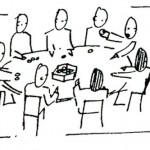 I attended a reexamination roundtable at the Patent Office last week where ideas for reexamination reform were proposed. The Patent Office listened and took notes. I thought it was a very productive meeting overall. As the various speakers presented their comments to the questions posed by the Office, it reminded me how everyone views reexamination differently:
I attended a reexamination roundtable at the Patent Office last week where ideas for reexamination reform were proposed. The Patent Office listened and took notes. I thought it was a very productive meeting overall. As the various speakers presented their comments to the questions posed by the Office, it reminded me how everyone views reexamination differently:
- Patent Owners who are trying to enforce their patents want a fair system that will not amount to a tool of delay and thin or meritless attacks on their patents;
- Businesses and in-house counsel need a predictable system that can be used to challenge inferior patents and nuisance assertions;
- Judges need to know that if a case is stayed pending reexamination, there will be a reasonably expedient final decision that can be used for the litigation;
- Examiners need time and tools to help process unusually large and complicated reexaminations; and
- The Patent Office needs clear rules that are fair to both sides, and can reach finality of a reexamination with special dispatch.
But right now we don’t have adequate metrics to know the situation, much less to measure progress. What do I mean by that?
Variation in Size and Complexity
For example, perhaps we should be tracking reexamination progress based on complexity:
- Some reexaminations involve 5 claims. Some involve 50 claims. There is no reason why a 50 claim reexamination should take the same amount of time and resources as a 5 claim reexamination.
- One reexamination may involve 4 grounds of rejection and another may involve 8.
- One reexam request is 50 pages. One is 2000 pages.
- One reexamination involves several petitions. Another involves no petitions.
- One reexamination involves substantial claim amendments (including, adding new claims). Another involves cancellation of claims. Yet another has no amendments.
We could be counting claim volume as a metric, as opposed to just disposition of matters without regard to claim volume. We could be tracking the disposition of petitions, pages of reexamination request, volume of SNQs, or any number of other metrics indicative of the size or complexity of a matter.
Variation in Timing — Especially due to Procedural Variations
Perhaps we should be tracking more information about pendency and measurement of time. We should get more visibility into the timing of reexaminations at various stages. My current understanding of PTO statistics on reexaminations is that they often cite the time to NIRC. That does not seem fair to the CRU, because the statistics do not seem to separate the amount of time in the CRU from the amount of time at the BPAI or the Federal Circuit. That means that the pendency of reexaminations will scale with the numbers of appeals filed. Perhaps the number in appeals is statistically strong or weak enough that this metric is a reliable indicator of pendency, but I do not see enough information to discern that. And as the volume of cases increases, any change in appeal volume would change the statistical significance of past numbers. Anyone with better insight and information is encouraged to send that to me and I will post it if appropriate.
A Little More Data Would Go a Long Way
One size does not fit all when it comes to reexamination. Of course, you cannot measure everything, but you also cannot manage what you do not measure. A bit more detail in the figures would go a long way to measuring progress in the future.

Leave a Reply